
08 June 2020
Well in our case, “TAP” is an acronym for “Traffic Access Point” or “Test Access Point” and is a hardware device inserted at a specific point in a network where data can be accessed for testing or troubleshooting purposes. Network TAP's are mainly used to monitor the network traffic between two points in a network infrastructure

Figure 1. Network TAP
A network TAP typically consists of four ports: a network port A and B and two monitoring ports A and B. The network ports collect traffic from the network. Network port A receives the Eastbound traffic and port B receives the Westbound traffic. The monitoring ports provide a copy of this traffic to an attached monitoring device. Monitor port A will copy the Eastbound traffic and monitor port B will copy the Westbound traffic.

Figure 2. Copper and Fiber Network Link
Typically, a network TAP is placed between two points in the network. The network cable between points A and B is replaced with a pair of cables, which are then connected to the TAP. Traffic is passively routed through the TAP, without the network’s knowledge. This allows the TAP to make a copy of the traffic, which is sent out of the monitoring port to be used by another tool without changing the network traffic flow.
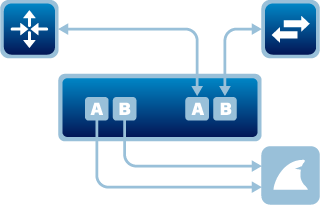
Figure 3. TAP inserted in a Network Link
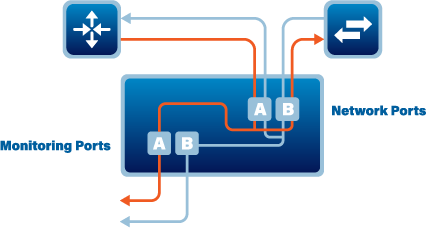
Figure 4. Network TAP Traffic Flow
Why do we need a Network TAP?
There are different methods for gaining access to your network. Some of the traditional methods used for gaining access to network traffic include using a SPAN/VACL port on your switch or connecting a monitoring device in-line on the network. There are challenges with both scenarios and are easily resolved with a TAP without introducing a point of failure. The Network TAP (also known as a Breakout TAP) is the only TAP that will guarantee copying all of the network traffic, including errors, to the monitoring ports A and B. Monitor port A gets the Eastbound traffic and monitor port B gets the Westbound traffic.
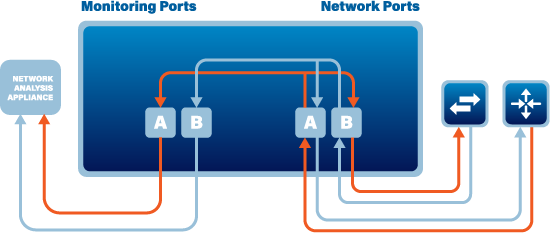
Figure 5. Network TAP Traffic Flow
What are other types of TAPs used on a network?
Although the Network TAP is the TAP that lets you see all the traffic running through your network, there are other types of TAPs that can be used on a network. Two for when it is not important to see all of the traffic and one to be used with monitoring in-line devices like an Intrusion Prevention System (IPS).
Aggregating TAPs allow you to take the eastbound and westbound network traffic and aggregate it out to a single monitoring port. This will allow you to use just one monitoring port to see your eastbound and westbound traffic aggregated together on one monitor port.
What are other types of TAPs used on a network?
Although the Network TAP is the TAP that lets you see all the traffic running through your network, there are other types of TAPs that can be used on a network. Two for when it is not important to see all of the traffic and one to be used with monitoring in-line devices like an Intrusion Prevention System (IPS).
Aggregating TAPs allow you to take the eastbound and westbound network traffic and aggregate it out to a single monitoring port. This will allow you to use just one monitoring port to see your eastbound and westbound traffic aggregated together on one monitor port.
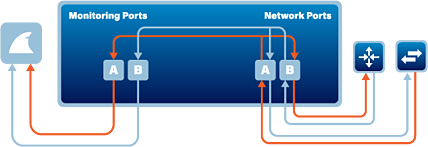
Figure 6. Aggregate TAP Flow
SPAN/Regeneration TAPs will permit you to take unidirectional traffic from one network segment and send it to multiple monitoring tools. This allows you to send a single traffic stream to a range of different monitoring tools, each serving a different purpose.
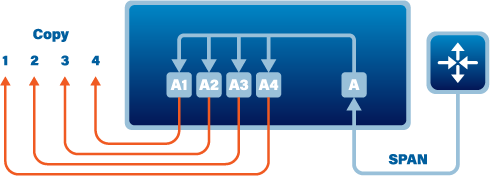
Figure 7. SPAN/Regenerating TAP Flow
Bypass TAPs (also known as In-Line TAPs) allow you to place an active network tool "Inline" on your critical links. These TAPs are used where monitoring devices need to be placed inline on the network to be effective but putting these devices inline will compromise the integrity of a critical network. By placing a Bypass TAP in place of the monitoring appliance and connecting the monitoring tool to the Bypass TAP, you can guarantee that the network link will continue to flow, and the in-line device will not become a ‘point of failure’.
"As long as the monitor appliance is on-line, it will keep returning the heartbeat packets received from the TAP back to the TAP keeping the in-line appliance from becoming a point of failure. If the monitor appliance should go off-line for any reason, the heartbeats will no longer be returned to the TAP causing the TAP to switch to the by-pass mode."
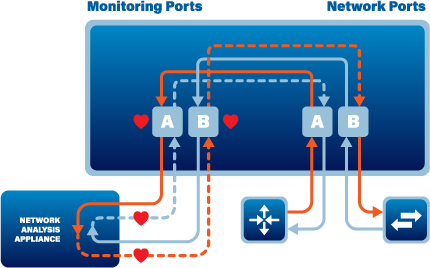
Figure 8. Bypass TAP Flow Normal Operation
There are different problems when a tool is installed in-line. Especially when dealing with a critical network, it is essential that the network is available all the time because down time can be very costly. When a device is installed in-line, the network must be brought down every time updates are required, or the tool needs to be re-booted. Similarly, if the monitoring tool fails, the network will go down as well.
These problems can be resolved by using a Bypass TAP. When using an In-Line TAP, you will be guaranteed that every packet being sent from the network will get to the monitoring tool. Because these devices can never be over-subscribed, they always pass every packet including layer 1 and layer 2 errors.
The Bypass TAP when it is in its normal operating mode will keep critical traffic running through the in-line appliance and at the same time will send ‘heartbeat’ packets to the in-line appliance and as long as the in-line appliance passes the heartbeat packets back to the in-line TAP the TAP will remain in the in-line mode. If the in-line appliance should go off-line for any reason, the In-Line TAP will stop getting the heartbeat packets. The In-Line TAP will switch to the by-pass mode until the TAP starts to receive heartbeat packets again which will indicate that the in-line appliance is back on-line.
"When the monitor appliance goes off-line for any reason, the heartbeat packets are no longer returned to the TAP causing the TAP to bypass the monitor appliance and keep the critical link running."
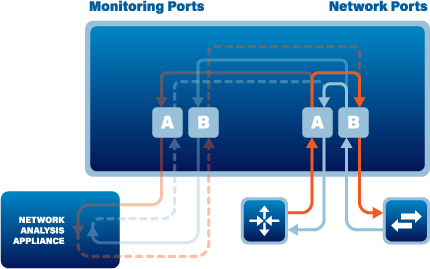
Figure 9. Bypass TAP Flow in "Bypass" Mode
For our solutions: Network Analysis and Accessories